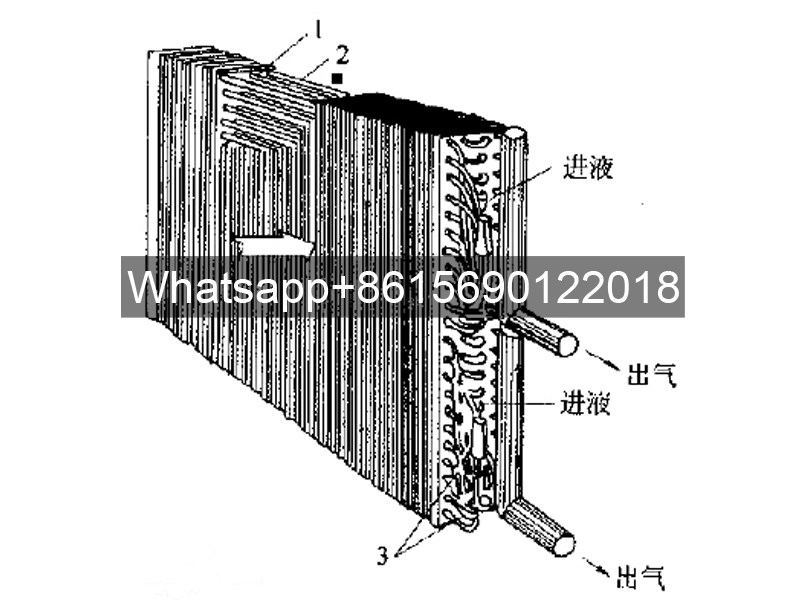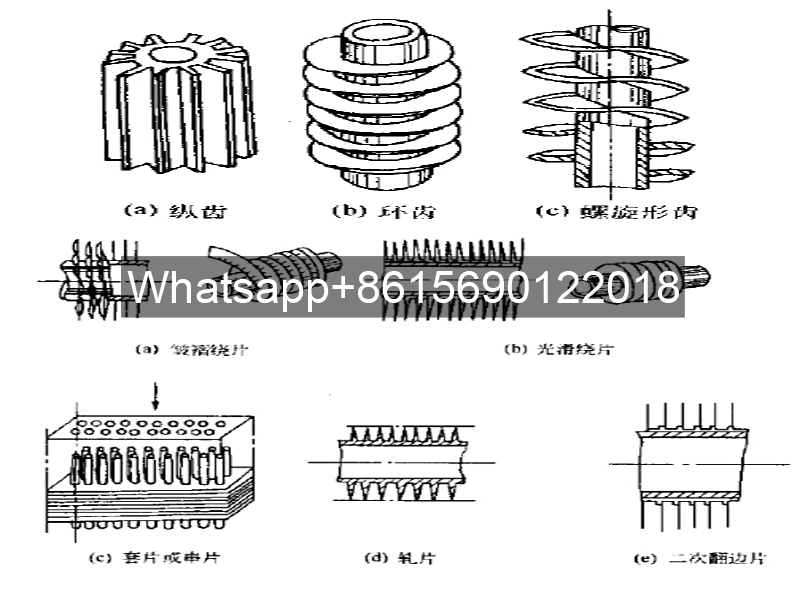The finned tube heat exchanger is one of the earliest and most successful discoveries in improving tubular heat exchange. This method remains the most widely used of all methods for enhancing heat transfer on tubular heat exchange surfaces. It is not only applicable to single-finned tube heat exchangers, but is also widely used in power, chemical, petrochemical, air conditioning, and refrigeration engineering.

Finned Tube Heat Exchanger Manufacturer and Supplier-China Fin Tube Factory
Types of Finned Tubes
The basic heat transfer element of a finned tube heat exchanger is a finned tube, which is composed of a base tube and fins. The base tube is typically a round tube, but elliptical and flat tubes are also available.
The surface structures of the fins include flat fins, interrupted fins, corrugated fins, and perforated fins. The latter two are highly efficient heat exchanger types.
Datang Finned Tube Technical Parameters
| PRODUCT | TYPE | TUBE MATERIAL | FIN MATERIAL | TUBE SIZE | FIN SIZE |
| Heat Exchanger Finned Tube | Extruded Fin Tube | All Kind of Material can be applied | Aluminum A1100 | 15.88~50.8 | 7~11.5FPI |
| Fin Height Max 16mmH | |||||
| L-Foot Fin Tube | All Kind of Material can be applied | Copper C1100, C1220 | 12.70~50.8 | 7~11.5FPI | |
| (Wrap On Type) | Fin Height Max 16mmH | ||||
| G-Fin Tube (Embedded Type) | Aluminum A1100, A1050, A1060 | ||||
| High Frequency Welded Finned Tube | A179 Carbon Steel Tube | Carbon Steel Tube | 12.70~160 | 1.5~7FPI | |
| Stainless Steel Tube | Stainless Steel Tube | 0.8~3.2mm. Thickness | |||
| Alloy Steel Material | Alloy Steel Material | ||||
| Integral Copper & Copper Alloy High Finned Tube | C12200, C11000, C70600 | C12200, C11000, C70600 | 15.88~22.23 | 5~9FPI | |
| Max 12mm. H | |||||
| Oval Finned Tube | Carbon Steel Tube | Carbon Steel Tube | All Size Available | 5~15FPI | |
| Stainless Steel Tube | Stainless Steel Tube | ||||
| Alloy Steel Material | Alloy Steel Material | ||||
| Copper & Copper Alloy Tube | Copper & Copper Alloy Tube | ||||
| Monometallic Fin Tube | Low Fin Tube | Carbon Steel, stainless steel, titanium, copper, brass, nickel alloy, etc. | — | 9.52~40 | 12, 16, 19 28 FPI, etc. |
| Turbo-C Tube | |||||
| Turbo-E Tube | |||||
| Corrugated Tube | All Kind of Material | — | 6.35~40 | 2~9FPI |
Fin tube structure
1. Classification by structural type Fin tubes can be divided into two basic types: longitudinal and radial. Other types are the development and deformation of these two types. For example, large spiral angle fin tubes are close to longitudinal, and small spiral angle fin tubes are close to radial. The shapes of the fins are circular, rectangular and needle-shaped. In addition, the fins can be set outside the tube, called external fin tubes; or set inside the tube, called internal fin tubes or both internal and external fin tubes.

Fin Tube Structure Manufacturer and Supplier-China Fin Tube Factory
2. Classification by manufacturing process Fin tubes can be classified into integral fin tubes, welded fin tubes, high-frequency welded fin tubes and mechanically connected fin tubes according to the manufacturing process.
(1) Integral fin tubes are made by casting, machining or rolling, and the fins and tubes are integrated.
(2) Welded fin tubes are manufactured using processes such as brazing or inert gas shielded welding. Modern welding technology can connect fins of different materials together and can make fin tubes simple and economical to manufacture. They have good heat transfer and mechanical properties and have been widely used. Since the residue in the weld is not conducive to heat transfer and may even cause fracture, the welding process quality must be guaranteed when producing this type of finned tube.
(3) High-frequency welding finned tubes, using the high-frequency induction generated by the high-frequency generator, generates high temperature at the contact point between the tube surface and the fin, melts the two within a depth range of about 10μm, and then pressurizes the fins and tubes to form a whole. There is no flux or solder, it is simple to manufacture, has high productivity, and has excellent heat transfer and mechanical properties. This is the most ideal type of finned tube, which is being recognized and adopted by the majority of users.
(4) Mechanical connection finned tubes, usually have three types: winding type, inlaid type, sleeve type or string type. Wrapped finned tubes are simple to manufacture. The metal strip is fixed to one end of the tube by mechanical or welding methods, and the metal strip is tightly wrapped around the outer wall of the tube by the rotational torque of the tube. The other end is fixed to form a wound finned tube. The material of the winding strip can be copper strip, steel strip or aluminum strip.
Heat Transfer Calculation
The basic equation for heat transfer calculations for fin-tube heat exchangers is the same as for other tubular heat exchangers:
Where:
Heat transfer, W;
Overall heat transfer coefficient based on the base tube inner surface heat transfer area, W/(m²·°C);
Overall heat transfer coefficient based on the fin outer surface heat transfer area, W/(m²·°C);
Base tube inner surface heat transfer area, m²;
Fin outer surface heat transfer area, m²;
Logarithmic mean temperature difference, °C.
Simplifying the above equation yields
K¡F¡ = K. F.
Fin-tube Heat Exchanger Applications
Fin-tube heat exchangers are widely used in power, chemical, petrochemical, air conditioning, and refrigeration engineering, such as surface air coolers, air heaters, and fan coil units used in air conditioning.
The evaporator of the air cooler and the evaporator of the frost-free refrigerator used in refrigeration engineering are not only suitable for the flow of single-phase fluid, but also have great value for phase change heat transfer. Most of the fin-tube heat exchangers used for clean gas adopt a new and efficient fin surface structure to achieve a significant enhanced heat transfer effect.
 dtfinnedtube.com
dtfinnedtube.com

